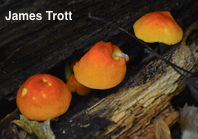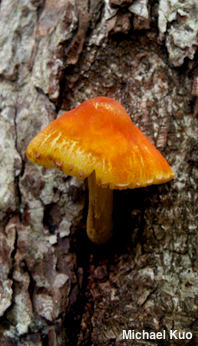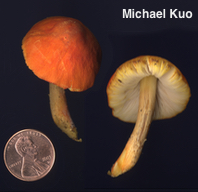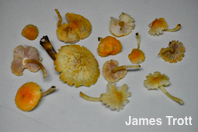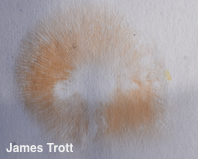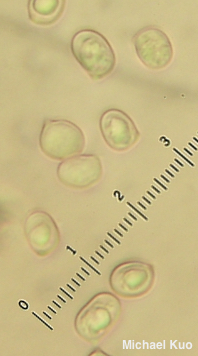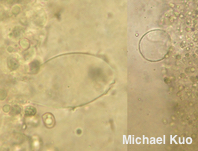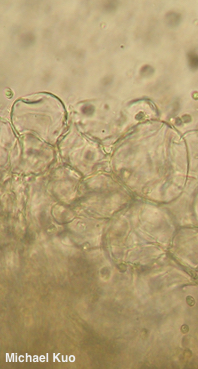| Major Groups > Gilled Mushrooms > Pink-Spored > Pluteus > Pluteus aurantiorugosus |

|
[ Basidiomycota > Agaricales > Pluteaceae > Pluteus . . . ] Pluteus aurantiorugosus by Michael Kuo, 27 December 2025 What a gorgeous mushroom! Listed as rare in most sources, Pluteus aurantiorugosus is easily recognized by its habitat on wood, its pink spore print, and its scarlet to deep orange cap. I have found exactly one specimen in thirty years of mushroom hunting, so I will add my "yes" to the chorus of authors who say it is infrequently encountered. Thanks to James Trott for documenting, collecting, and preserving Pluteus aurantiorugosus for study; his collection is deposited in The Herbarium of Michael Kuo.
Description: Ecology: Saprobic on decaying hardwood logs and stumps; growing alone or in small groups; summer and fall; originally described from Switzerland (Trog 1857); fairly widely distributed in Europe and in North America, where it is more common east of the Rocky Mountains than in western regions. The illustrated and described collections are from Illinois and Pennsylvania. Cap: 2–5 cm; convex at first, becoming broadly convex to nearly flat, sometimes with a central bump; dry or moist; bald, or slightly granular; the margin not lined, or only faintly lined, at maturity; bright scarlet to orange when young, fading to orangish yellow in age. Gills: Free from the stem; close or nearly crowded; short-gills frequent; whitish, becoming pinkish; often with yellowish edges. Stem: 3–6 cm long; 0.5–1 cm thick; equal; finely fibrillose; whitish to yellowish above, but flushed with the cap color below; basal mycelium white or yellowish. Flesh: Pale yellowish; unchanging when sliced. Odor: Not distinctive. Spore Print: Brownish pink. Microscopic Features: Spores 5.5–8 x 4–5 µm; ellipsoid; smooth; hyaline in KOH; inamyloid. Hymenial cystidia 40–60 x 12–35 µm; clavate to widely lageniform, or saccate to sphaeropedunculate; thin-walled; hyaline in KOH. Pileipellis a "cellular" cystoderm; elements to 50+ wide, subglobose, smooth, hyaline in KOH. Clamp connections not found. REFERENCES: (J. K. Trog, 1857) P. A. Saccardo, 1896. (Kauffman, 1918; Homola, 1972; Smith, Smith & Weber, 1979; Lincoff, 1992; Barron, 1999; McNeil, 2006; Miller & Miller, 2006; Boccardo et al., 2008; Minnis & Sundberg, 2010; Justo et al., 2011; Kuo & Methven, 2014; Baroni, 2017; Læssøe & Petersen, 2019; Kibby, 2020.) Herb. Kuo 09280301, 10312501. This site contains no information about the edibility or toxicity of mushrooms. |
© MushroomExpert.Com |
|
Cite this page as: Kuo, M. (2025, December). Pluteus aurantiorugosus. Retrieved from the MushroomExpert.Com Web site: http://www.mushroomexpert.com/pluteus_aurantiorugosus.html |
